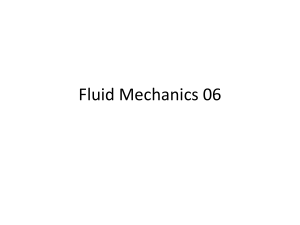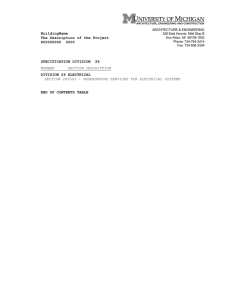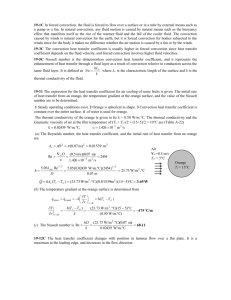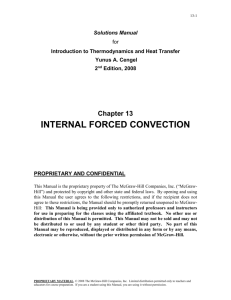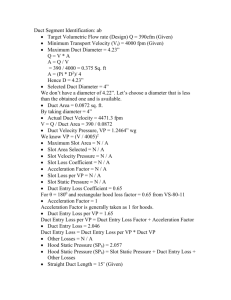Chapter 8 and 9 Solutions
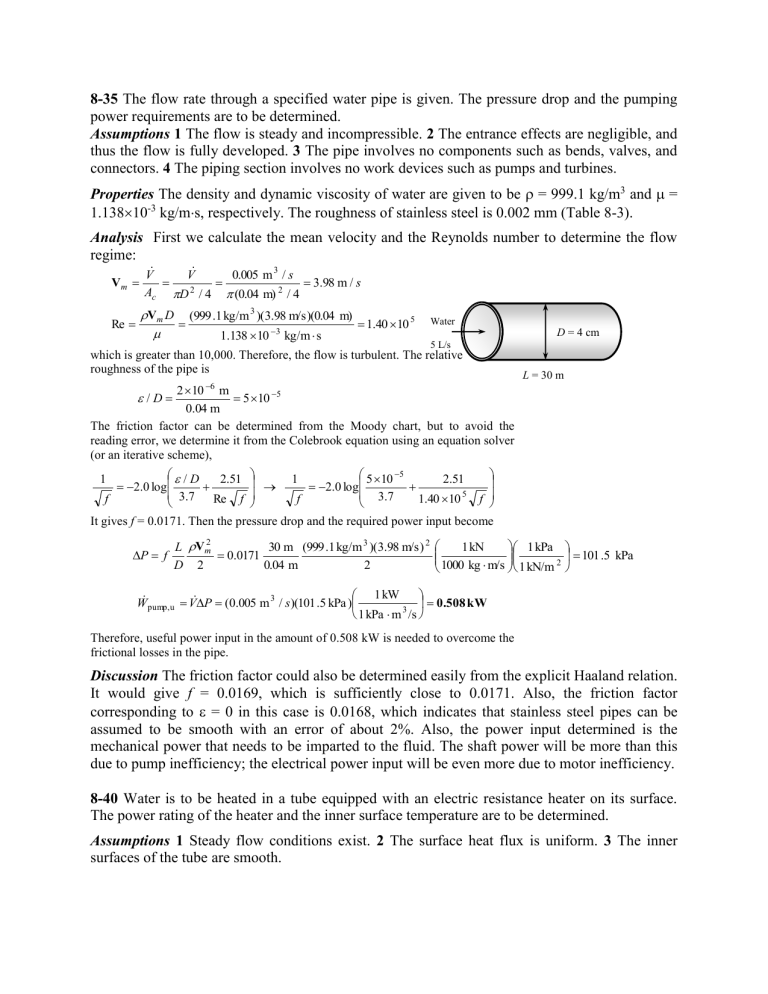
8-35 The flow rate through a specified water pipe is given. The pressure drop and the pumping power requirements are to be determined.
Assumptions 1 The flow is steady and incompressible.
2 The entrance effects are negligible, and thus the flow is fully developed. 3 The pipe involves no components such as bends, valves, and connectors. 4 The piping section involves no work devices such as pumps and turbines.
Properties The density and dynamic viscosity of water are given to be
= 999.1 kg/m
3
and
=
1.138
10
-3
kg/m
s, respectively. The roughness of stainless steel is 0.002 mm (Table 8-3).
Analysis First we calculate the mean velocity and the Reynolds number to determine the flow regime:
V m
V
V
0.005
m
3
/ s
3 .
98 m / s
A c
D
2
/ 4
(0.04
m)
2
/ 4
Re
V
m
D
( 999 .
1 kg/m
.
138
3
)(
10
3 .
98
3 m/s)(0.04
kg/m m)
1 .
40
10
5 Water
1
s
5 L/s which is greater than 10,000. Therefore, the flow is turbulent. The relative roughness of the pipe is
D = 4 cm
L = 30 m
/ D
2
10
6 m
0 .
04 m
5
10
5
The friction factor can be determined from the Moody chart, but to avoid the reading error, we determine it from the Colebrook equation using an equation solver
(or an iterative scheme),
1 f
2 .
0 log
/ D
3 .
7
2 .
51
Re f
1 f
2 .
0 log
5
10
5
3 .
7
2 .
51
1 .
40
10
5 f
It gives f = 0.0171. Then the pressure drop and the required power input become
P
f
L
D
V
2 m
2
0 .
0171
30 m
0.04
m
( 999 .
1 kg/m
3
)( 3 .
98 m/s)
2
2
1 kN
1000 kg
m/s
1 kPa
1 kN/m
2
101 .
5 kPa
pump, u
V
P
( 0 .
005 m
3
/ s )( 101 .
5 kPa )
1
1 kPa kW
m
3
/s
0.508
kW
Therefore, useful power input in the amount of 0.508 kW is needed to overcome the frictional losses in the pipe.
Discussion The friction factor could also be determined easily from the explicit Haaland relation.
It would give f = 0.0169, which is sufficiently close to 0.0171. Also, the friction factor corresponding to
= 0 in this case is 0.0168, which indicates that stainless steel pipes can be assumed to be smooth with an error of about 2%. Also, the power input determined is the mechanical power that needs to be imparted to the fluid. The shaft power will be more than this due to pump inefficiency; the electrical power input will be even more due to motor inefficiency.
8-40 Water is to be heated in a tube equipped with an electric resistance heater on its surface.
The power rating of the heater and the inner surface temperature are to be determined.
Assumptions 1 Steady flow conditions exist. 2 The surface heat flux is uniform. 3 The inner surfaces of the tube are smooth.
Properties The properties of water at the average temperature of
(80+10) / 2 = 45
C are (Table A-9)
(Resistance heater)
k
990 .
1 kg/m
3
0 .
637 W/m.
C
Water
10
C
3 m/s
D = 2 cm
/
0 .
602
10
6 m
2
/s
C p
4180 J/kg.
C
L
Pr
3 .
91
Analysis The power rating of the resistance heater is
V
( 990 .
1 kg/m
3
)( 0 .
008 m
3
/min )
7 .
921 kg/min
0 .
132 kg/s
m C p
( T e
T i
)
( 0 .
132 kg/s )( 4180 J/kg.
C )( 80
10 )
C
38,627 W
80
C
The velocity of water and the Reynolds number are
V m
V
A c
(8
10
3
/ 60 )
3
m / s
m)
2
/ 4
m / s
Re
V m
D h
(0.4244
m/s)(0.02
m)
0 .
602
10
6 m
2
/s
14 , 101 which is greater than 10,000. Therefore, the flow is turbulent and the entry lengths in this case are roughly
L h
L t
10 D
10 ( 0 .
02 m)
0 .
20 m which is much shorter than the total length of the duct. Therefore, we can assume fully developed turbulent flow in the entire duct, and determine the Nusselt number from
Nu
hD h k
0 .
023 Re
0 .
8
Pr
0 .
4
0 .
023 ( 14 , 101 )
0 .
8
( 3 .
91 )
0 .
4
82 .
79
Heat transfer coefficient is h
k
D h
Nu
0 .
637 W/m.
C
( 82 .
79 )
2637 W/m
2
.
C
0 .
02 m
Then the inner surface temperature of the pipe at the exit becomes
hA s
( T s , e
T e
)
38 , 627 W
T s , e
( 2637 W/m
2
.
C )[
( 0 .
02 m )( 7 m )]( T s
113.3
C
80 )
C
8-44 Oil flows through a pipeline that passes through icy waters of a lake. The exit temperature of the oil and the rate of heat loss are to be determined.
Assumptions 1 Steady operating conditions exist. 2 The surface temperature of the pipe is very nearly 0
C. 3 The thermal resistance of the pipe is negligible. 4 The inner surfaces of the pipeline are smooth. 5 The flow is hydrodynamically developed when the pipeline reaches the lake.
Properties The properties of oil at 10
C are (Table A-13)
893 .
5 kg/m
3
, k
0 .
146 W/m.
C
Oil
10
C
C p
2 .
325 kg/m.s,
1838 J/kg.
C, Pr
2591
10
6 m
2
/s
28750
0.5 m/s
D = 0.4 m
L = 300 m
T e
Analysis (a) The Reynolds number in this case is
Re
V m
D h
(0.5
2591 m/s)(0.4
10
6 m m)
2
/s
77 .
19 which is less than 2300. Therefore, the flow is laminar, and the thermal entry length is roughly
L t
0 .
05 Re Pr D
0 .
05 ( 77 .
19 )( 28750 )( 0 .
4 m )
44 , 384 m which is much longer than the total length of the pipe. Therefore, we assume thermally developing flow, and determine the Nusselt number from
Nu
and hD k
3 .
66
1
h
k
D
Nu
0 .
065
0 .
04
(
( D
D
/
/
L
L )
)
Re
Re
Pr
Pr
2 / 3
3 .
66
0 .
065
0 .
4 m
300 m
( 77 .
19 )( 28 , 750 )
1
0 .
04
0 .
4 m
300 m
( 77 .
19 )( 28 , 750
)
2 / 3
0 .
146 W/m.
C
( 24 .
47 )
8 .
930 W/m
2
.
C
0 .
4 m
24 .
47
Next we determine the exit temperature of oil
A s
DL
( 0 .
4 m)(300 m) = 377 m
2
V
A c
V m
D
2
4
V m
( 893 .
5 kg/m
3
)
(0.4
m)
2
4
(0.5
m/s) = 56.14
kg/s
T e
T s
( T s
T i
) e
hA s
/( C p
)
0
( 0
10 ) e
( 8 .
930 )( 377 )
( 56 .
14 )( 1838 )
9.68
C
( b ) The logarithmic mean temperature difference and the rate of heat loss from the oil are
T ln
T e ln
T s
T s
T i
T e
T i
ln
9 .
68
0
0
10
9 .
68
10
9 .
84
C
hA s
T ln
( 8 .
930 W/m
2
.
C )( 377 m
2
)( 9 .
84
C )
3 .
31
10
4
W
3.31
kW
The friction factor is f
64
Re
64
77 .
19
0 .
8291
Then the pressure drop in the pipe and the required pumping power become
W
P pump, u
f
L
D
V m
2
2
0 .
8291
300 m ( 893 .
5 kg/m
3
)( 0 .
5 m/s )
2
0 .
4 m 2
1 kN
1000 kg
m/s
1 kPa
1 kN/m
2
69 .
54 kPa
V
P
( 0 .
0628 m
3
/s )( 69 .
54 kPa )
1
1 kPa kW
m
3
/s
4.364
kW
Discussion The power input determined is the mechanical power that needs to be imparted to the fluid. The shaft power will be much more than this due to pump inefficiency; the electrical power input will be even more due to motor inefficiency.
8-55 The components of an electronic system located in a rectangular horizontal duct are cooled by forced air. The exit temperature of the air and the highest component surface temperature are to be determined.
Assumptions 1 Steady flow conditions exist. 2 The inner surfaces of the duct are smooth. 3 The thermal resistance of the duct is negligible. 4 Air is an ideal gas with constant properties. 5 The pressure of air is 1 atm.
Properties We assume the bulk mean temperature for air to be 35
C since the mean temperature of air at the inlet will rise somewhat as a result of heat gain through the duct whose surface is exposed to a constant heat flux. The properties of air at 1 atm and this temperature are (Table A-
15)
k
1 .
146 kg/m
3
0 .
02625 W/m.
C
Air duct
16 cm
16 cm
C
p
1 .
654
10
5 m
2
/s
1007 J/kg.
C
Pr
0 .
7268
90 W
L = 1 m
Analysis ( a ) The mass flow rate of air and the exit temperature are determined from
Air
32
C
0.65 m
3
/min
V
( 1 .
146 kg/m
3
)(0.65
m
3
/min) = 0.7449
kg/min = 0.01241
kg/s
C p
( T e
T i
)
T e
T i
C p
32
C +
(0.85)(90 W)
( 0 .
01241 kg/s)(100 7 J/kg.
C)
38.1
C
( b ) The mean fluid velocity and hydraulic diameter are
V m
D h
V
A c
4 A c
P
0 .
65 m/min
(0.16
m)(0.16
m)
4 ( 0 .
16 m)(0.16
m)
4 ( 0 .
16 m)
25 .
4 m/min
0 .
16 m
= 0.4232
m/s
Then
Re
V m
D h
(0.4232
1 .
654 m/s)(0.16
10
5 m
2 m)
/s
4093 which is greater than 2300. Also, the components will cause turbulence and thus we can assume fully developed turbulent flow in the entire duct, and determine the Nusselt number from
Nu
hD h k
0 .
023 Re
0 .
8
Pr
0 .
4
0 .
023 ( 4093 )
0 .
8
( 0 .
7268 )
0 .
4
15 .
70
(note from Dr. Okamoto: They really should have checked to see if it was fully developed or not.
It’s actually developing flow. We don’t have an equation in our book for developing turbulent flow. You probably get about the same amount of error by using the turbulent fully developed flow equation shown above as you would get using the laminar developing flow equation, which we do have. Both equations will underestimate h. To get a more accurate number we’d need to do a bit of research to get an equation for this particular geometry. So here you could use Equ. 8-
62 with “2.98” substituted in for the “3.66”.)
and h
D k h
Nu
0 .
02625 W/m.
C
( 15 .
70 )
0 .
16 m
2 .
576 W/m
2
.
C
The highest component surface temperature will occur at the exit of the duct. Assuming uniform surface heat flux, its value is determined from
/ A s
h ( T s , highest
T e
)
T s , highest
T e
/ A s h
38 .
1
C +
(0.85)(90 W)/
4(0.16
m)(1 m)
(2.576
W/m
2
.
C)
84.5
C
9-77 A vertical plate in water is considered. The forced motion velocity above which natural convection heat transfer from the plate is negligible is to be determined.
Assumptions 1 Steady operating conditions exist.
Plate,
T s
= 60
C
Properties The properties of water at the film temperature of
( T s
+ T )/2 = (60+25)/2 = 42.5
C are (Table A-15)
6
K
-1
L = 5 m
Analysis The characteristic length is the height of the plate L c
= L
= 5 m. The Grashof and Reynolds numbers are
Gr
g
( T s
2
T
) L
3
( 9 .
81 m/s
2
)( 0
( 0 .
.
0004
65
K
6
10
-1
)( 60 m
2
/s
)
2
25 K )( 5 m )
3
4 .
063
10
13
Re
V
L
0 .
65
V
( 5 m )
10
6 m
2
/s
4 .
6
10
6
V
Water
T = 25
C
V and the forced motion velocity above which natural convection heat transfer from this plate is negligible is
Gr
Re
2
0 .
1
4 .
063
10
13
( 4 .
6
10
6
V
)
2
0 .
1
V
2.62
m/s



